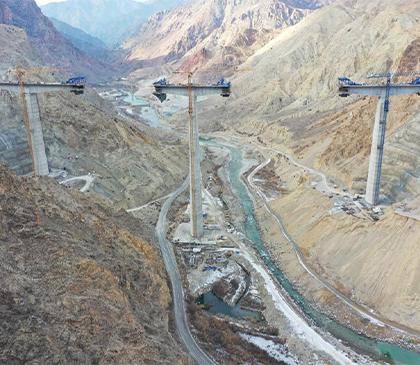Piers & Pylons
Widely differing shapes and designs for extraordinary bridges

Piers are erected on footed foundations and carry the supporting structure between the abutments. They consist of foundation, pier shaft and pier head. They connect to the superstructure either monolithically (flexurally rigid) or supported (articulated and/or movable). Pylons are steel or concrete uprights from which the roadway is suspended on stayed cables. Pylons transfer deflection forces from the suspension cables into the foundations. Pylons come in innumerable shapes such as diamond, A, or H, and so on.
Construction Methods
Self-climbing (crane independent)
Structure-guided and all-hydraulic
The built-in hydraulics enable simultaneous repositioning of large multiple-platform assemblies without exposed fall hazards. Spacious, high-capacity working platforms are ideal for the construction workflow.
Structure-guided and with mobile hydraulic drive
Climbing systems with mobile drives are the first step into the world of automatic climbing. Guided at all times on the structure, they free up the construction crane and can be repositioned even at high wind speeds.
Crane-dependent climbing
Structure-guided
Guided at all times on the structure, the climbing system can be repositioned even at high wind speeds. So climbing operations are less wind-dependent, faster and safer.
Not-structure-guided
Firmly interconnected, the shaping wall formwork and the climbing scaffold are quickly crane-lifted as a single unit. The different system versions combine ease of working with trouble-free adaptation to different forms of usage.
Challenging geometry
Piers and pylons come in a multitude of shapes.
- various heights
- different cross-sections
- solid or hollow cross-sections
- varying wall thicknesses
- tapering and widening sections
- inclinations
- unions
- architecturally challenging free forms and surfaces
Reinforcement and embedded parts
Climbing working platforms separate the formwork and reinforcement operations. Work proceeds on several levels at once, so the cycle time can be shortened. The installation of cable boxes is one of the factors that have to be taken into account in the planning concept for the working platforms.
Safe access systems
To be able to keep the workers on the climbing formwork supplied in the event of a crane outage, the safety concept for the site includes a stationary system of vertical access. Doka safety systems ensure safe and reliable up and down access after each climbing operation. This is all allowed for in the formwork concept. Site-supplied access systems and site elevators can also be incorporated into the concept.
- Stair tower 250
- Stair tower d3
- Working scaffolds
Get in touch
The international experience of Doka gives you pooled, concentrated knowledge for a successful project. Your contact person will help you find the best individual solution, to make your project's 'bottom line' a success, too. In short: expert specialised formwork planning with lasting benefits for your bridge construction project.



















